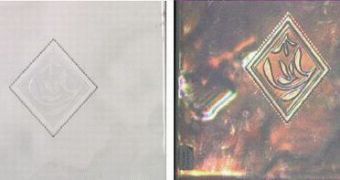Picasso's funs could get cubist pictures at one century after the cubism emerged.
Because now, Andrew Forrest, an engineer at the Imperial College of Science, Technology and Medicine in London, has developed a multi-angle scanner for portraying objects.
Imaging systems, from digital cameras to human eye, employ light reflected from a sole narrow range of angles to create an image.
But by combining the light from multiple angles, we could get much more information on surface texture, and data we could not detect before. "As far as I know, this is the only scanner that images multiple angles simultaneously. Other scanners have been used for very high spatial resolution, imaging at angles etc., but in general these have been special purpose, that is, not an attempt to get all possible information at once. The main advantage of this scanner is imaging multiple angles simultaneously. This allows accurate comparisons of light from the same point at different angles allowing detection of scratches, changes in texture, etc," said Forrest.
The high-speed, high-resolution scanner can get views of objects from six different angles over a range of four degrees. The final goal of Forrest's investigation is to achieve separated angles, wavelengths and polarizations of light from an object. "I thought that it might be better to produce an imaging system that gave as much information as possible that could be used in a wide variety of applications, covering the uses of several special purpose instruments. This is the origin of attempting to get every angle, wavelength and polarization at once", Forrest explained.
The scanner is based on a parabolic mirror, two flat mirrors and a detector. A 15-mW helium-neon laser glows parallel light beams onto a rotating prism, which heads them toward the parabolic mirror.
After being reflected by the two flat mirrors and the object, the light goes back to the parabolic mirror and finally reaches the detector, which selects them in different light angles before they are superimposed to make an image.
The high-speed scanner can take 4000 scans per second. "Because of the nature of a scanner, at least one optical component must be as big as the object being viewed. If this were not the case, different parts of the object would have to be illuminated and viewed at different angles, negating the point of the scanner. This design just uses one large curved optical component. This is the absolute minimum possible", Forrest said.
The scanner possesses a resolution of about 100 pixels per mm2, not very high by scanner standards and a typical 400-mm surface would have about 100 million data points.
The system was tested on ceramic tiles, and detected more prominent surface textures of the tiles, including fingerprints and scratches. "Possible applications include quality control, which is where the work started. I have had interests ranging from jet engine parts to leather production. Forensic imaging, where scuff marks or scratches on a surface can be very important, is another one of the areas I would like to pursue", he said.
The scanner is limited by the data acquisition and storage and laser source also, that causes speckles ("noise") on the image. "Since the published work, we have developed a system that uses more optics to obtain an angular range of up to 40 degrees and 16-plus channels. Speed of operation is relatively easy to obtain; it just costs money. The system needs a high-power laser, very fast sensitive detectors and a very fast rotating prism scanner", Forrest added.

 14 DAY TRIAL //
14 DAY TRIAL //